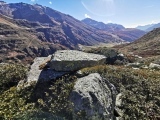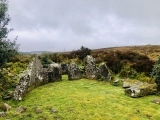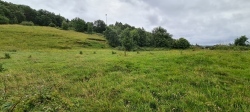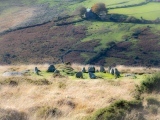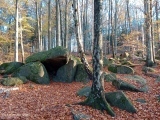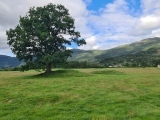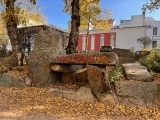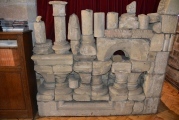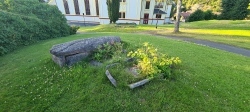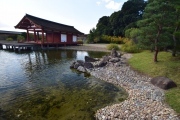Andy Burnham's Blog, page 46
November 12, 2024
Zoca di Guant
There are two low stone walls running the length of the Andossi plateau, one marks the pathway among the houses and develops very close to a modern white road (a continuation of an old Roman way), the other is pretty much abandoned. One big boulder with some big flat rocks strewn underneath - maybe a destroyed burial site? I publish the picture but I can't say one way or another. Also right at the end of the wall, on top of a gully filled with stones, there was, clearly visible even from a distance, the large slab cover of a potential burial site!
Published on November 12, 2024 08:45
Ballywholan
200 metres NE of the Greaghnasunna Bridge over the Fury river, 5.6 km SE of Clogher, stands a small, relatively well-preserved tomb with much of its cairn. It is about 20 metres long, and composed of two double-chambered galleries and forecourts. A frontal kerb joins the SE court to the sides of the cairn. The NE court has tall flanking-stones, and one of the jamb-stones bears a cup-mark. At the end of the 19th century a local farmer took one of the lintel-stones to build a barn, but when it was cemented in it apparently emitted a 'strange radiance'. The farmer returned it to the tomb – whence it subsequently disappeared, presumably incorporated in another local building by a less-sensitive man.
Published on November 12, 2024 08:37
November 11, 2024
Øygarden
The settlement at Øygarden is an example of the ring-shaped or circular-shaped iron age settlements known from several locations in south west and north Norway, like Klauhauane, Auna Motland, Vollmoen etc. Øygarden is also typically placed for one of the Iron age ring settlements in an open grassy field on the north side of a small mountain and with access to the sea to the North. The site consists of 10 house tufts and 2 round barrows.
Published on November 11, 2024 11:04
Nine Stones (Belstone)
A nice neat little stone circle on the moors below Belstone Tor on the common to the south of the village of Belstone, Devon. This circle is almost certainly the remains of a round burial cairn, and traces of the burial chamber can be seen within the circle. There are gaps around the circle, suggesting that originally there were originally some forty stones. None of the stones are very large, the tallest being about 0.9m (3 feet). There is considerable upheaval in the centre of the circle, evidence of a robbed cairn and destroyed cist.
Published on November 11, 2024 07:23
November 10, 2024
Sohland Opferbecken
A natural shelter-like rock formation called Steinzeitkino (stone age cinema). There is an solar alignment visible from the Opferbecken stone along the formation towards equinox sunrise. On the inside on the left upright stone is a carving of a figure looking towards the sky. Date unknown, possibly modern. On midday at winter solstice a beam of light enters the shelter and illuminates the back of the head of the figure.
Published on November 10, 2024 10:02
Grindheimsveien-Sør
A barrow cemetery located in a large grassy flat moraine terrace with several other barrow cemeteries and burial monuments. Findings are known from the stone age up to late Iron age.
The cemetery at Grindheimsveien south consists of 25 barrows and cairns. Four round barrows and one burial cairn are large and easily visible and clearly marked in the terrain.
The cemetery at Grindheimsveien south consists of 25 barrows and cairns. Four round barrows and one burial cairn are large and easily visible and clearly marked in the terrain.
Published on November 10, 2024 09:32
November 7, 2024
Engelbecken Steine
Two large modern stone arrangements in the Engelbecken park in Berlin Kreuzberg. One arrangement was built in shape of a dolmen and one looks like a modern standing stone (around 3-4 m tall). Complete with equally modern graffiti!
Published on November 07, 2024 04:18
November 6, 2024
St Andrew's Church (Bothal)
The church guide for St Andrew's Church in Bothal tells us there has been a church on this site for over 1,000 years, the evidence being a number of Anglo Saxon stone fragments which have been incorporated into the present building. The collection of architectural fragments seen in the top photo can be found at the north western end of the church, forming part of the wall of a make-do vestry. Brilliant use of all the different pieces, I loved picking out all the funny faces amongst them!
Published on November 06, 2024 09:26
Kjerkheia
The church park and yard at Grimstad church have several burial monuments. Some of these have been moved to this location from other places in and around Grimstad. There are several cists or stone coffins, a standing stone and a rectangular stone setting - see the other photos on this page.
Published on November 06, 2024 09:21
November 5, 2024
Heijō-kyō Palace garden ruin (eastern garden)
In 710 CE, the Japanese capital was moved to Heijō-kyō (present day Nara) from southern Asuka district. The palace adopted the grid system of the city of Chang’an of the Chinese Tang dynasty. Then the emperors of Heijō-kyō palace were annoyed by the growing force of the Buddhist priests in the new capital who came to be the independent military power.
Published on November 05, 2024 09:21

